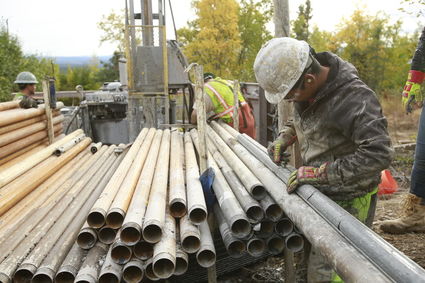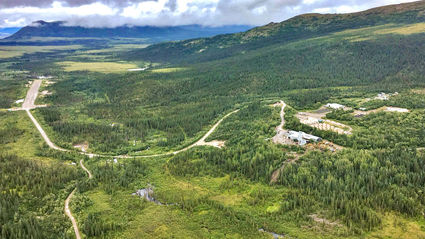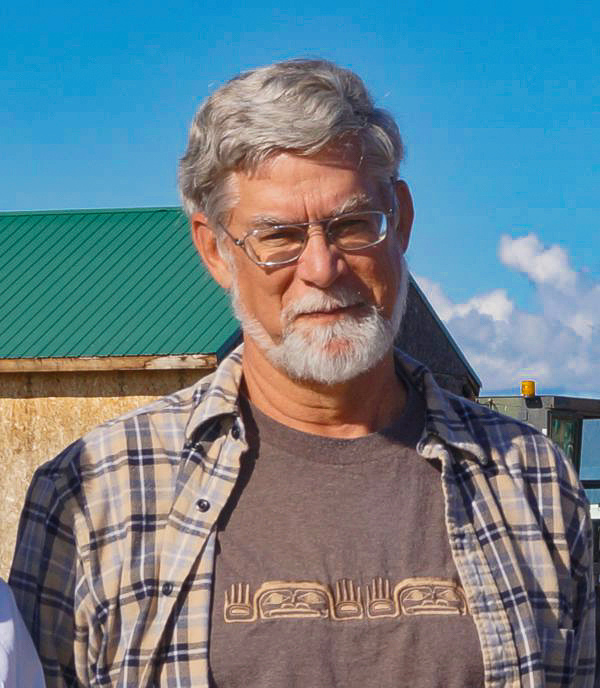Mixed economic signals for Alaska mining
Data shows global exploration trending higher; state statistics paint gloomier picture, job numbers don't seem to add up North of 60 Mining News – January 1, 2019
Last updated 9/25/2020 at 10:34am

Novagold Resources Inc.
A driller during the 2017 optimization program at Donlin Gold, a 39-million-ounce gold project in Southwest Alaska owned by Novagold Resources and Barrick Gold. It has been previously estimated that this mine will provide some 3,000 high paying jobs during the construction phase, which should help bolster job growth in Alaska's mining sector.
As the year waned, Alaska's mining industry reported some of the last of its 2018 seasonal field results while the University of Alaska and state of Alaska released some current and projected state-wide economics. At the same time, some macro-economic data was released for the global mining industry. Combined, these figures show a mix of encouraging and not so encouraging trends facing the Alaska mining industry.
At the global scale, things for the mining industry are looking up. S&P Global reports that global nonferrous exploration spending was up 19 percent in 2018, to US$10.1 billion worldwide. The number of active exploration companies moved higher for the first time since 2012, increasing by 8 percent to 1,651 companies. Budgets for junior exploration companies have finally shown signs of life, increasing 35 percent in 2017. Some metals, like the "battery boys" – lithium and cobalt – did better than others with these two metals seeing exploration budgets increase a whopping 82 percent in 2018 and up more than 500 percent since 2015. Canada, Australia and the United States remain the top three destinations of choice for mineral exploration worldwide.
As encouraging as that information is, things are not so rosy here in Alaska. The University of Alaska, Anchorage's Institute of Social and Economic Research recently reported that unemployment rates continued to lag well behind the national average, tracking at 6.4 percent while the national average plunged below 3.5 percent. Of the six states whose economies are largely oil dependent, Alaska is the only state that remained in a recession following the bottom of the oil market in 2016. With oil prices recently headed south again, and Alaska production forecast to fall for the fourth straight year, it looks like "more of the same" for Alaska's economy in 2019.
While this was happening, Alaska wages have dropped for 36 straight months when compared on a year-to-year basis. Estimates for projected job growth by industry for the period 2016 to 2026 showed Alaska health care and social service jobs increasing by an estimated 10,134 jobs while the mining and oil industries, combined, were projected to see job growth of 112 jobs.
Wait, what?! So, the industries that have the most potential to bring high quality, high wage jobs to places in Alaska, where jobs are scarce, are going to add only a paltry 112 new jobs in the next eight years? Color me uber-skeptical of this figure but if this projection is true, it goes to the heart of a question recently asked by a mining company executive who is new to Alaska: "Why aren't there more mines in Alaska?" Good question.
WESTERN ALASKA
Nova Minerals Ltd. announced an upward revision of its Estelle project exploration target estimate to 2.2 to 5.3 million ounces of gold based on the results of the scout drilling and the utilization of pathfinder element geochemistry obtained from the chip samples and mapping campaign completed this past summer on the Oxide gold prospect. This resource estimate is based on tonnages of 115 million to 249 million metric tons grading 0.6 to 0.67 grams of gold per metric ton. The Oxide prospect is one of 15 highly prospective occurrences on the Estelle property. The lower end of the estimate range assumes a 780-meter strike length by 190 meters true width by 300 meters depth. Using a 2.6 specific gravity value supports a minimum tonnage of 115 million metric tons and using weighted average grade of 0.60 g/t gold provides a lower range exploration target of 2.2 million oz of gold. The upper end of the estimated range assumes 890 meters of strike length by 360 meters true width by 300 meters depth. Using a 2.6 specific gravity value supports a minimum tonnage of 249 million metric tons and using weighted average grade of 0.67 g/t gold provides an upper range exploration target of 5.3 million oz of gold. Due to unexpected delays with the commencement of the drilling program and winter setting in earlier than expected only two holes were drilled at the Estelle Oxide prospect in 2018. Reverse circulation hole OX18RC001 was terminated at 36.57 meters due to excessive ground water encountered in this hole and did not penetrate the induced polarization geophysical anomaly targeted. Drill core showed significant intercepts of arsenopyrite mineralization with minor sulfides. Assays revealed widespread arsenic mineralization up to 2,790 parts per million, with an average of 989 ppm arsenic for the entire hole. Gold assayed generally less than 0.14 g/t gold for the majority of the hole, with the highest intercept 1.52 meters grading 0.67 g/t gold. Reverse circulation hole OX18RC002 was terminated at 89.91 meters due to the on-set of winter weather. Drill core showed significant intercepts of arsenopyrite mineralization with minor sulfides. Assays returned up to 6,940 ppm arsenic, with an average of 1,147 ppm for the entire hole. Two zones of mineralization were encountered from 38.1 meters to 47.24 meters and 54.86 meters to end of hole (89.91 meters). Gold assayed generally less than 0.11 g/t gold for each mineralized zone with the highest intercept being 1.52 meters grading 0.81 g/t gold.
Redstar Gold Corp. announced its half yearly operational activities summary for its Unga gold-silver project near Sand Point. The most significant accomplishment was completion on an industry compliant technical report that outlined 32 distinct prospects over the 240 square kilometer (93 square miles) project. The report also recommended more focus on prospects such as Zachary Bay and Centennial, and confirmed that the Shumagin zone, which remains open at depth and along strike, warrants additional drilling. In line with this work is a parallel effort to compile, synthesize and digest all past work conducted on the project. The company indicated it was reviewing its options for 2019, including conducting its own highly selective exploration programs and seeking partnerships to explore and develop one or more areas of the project. The company also reported that it has renewed its surface access agreement with Unga Village Corporation and have initiated the process leading to extension of its sub-surface agreement with the Aleut Corporation. This extension will renew the company's sub-surface rights on lands outside of its patented and state mining claims.
ALASKA RANGE
White Rock Minerals Ltd. announced additional prospect discoveries at its 117,000-acre Red Mountain volcanogenic massive sulfide project in the eastern Bonnifield District. A regional stream sampling program highlighted eight priority anomalies that warrant immediate follow-up ground reconnaissance, surface sampling and geophysics prior to drill targeting. Multiple base metal anomalies were detected over the project area, including one stream sample returning 1.1 percent zinc in an area towards the top of the prospective volcanogenic massive sulfide stratigraphy to the west of the Dry Creek deposit. No previous exploration had been done in the immediate catchment area. In addition, the area of the northern limb of the Sheep Creek synform, known as the Glacier Creek trend, displays footwall sulfide alteration that extends for over 10 kilometers along strike. The stream sediment survey has identified four discrete high priority targets within this area of alteration.
Millrock Resources Inc. announced that a subsidiary of Kinross Gold Corp. has provided notice that effective Dec. 8, Kinross terminated its option on the Liberty Bell gold project near Ferry. Millrock intends to seek another partner to drill test the numerous targets that have been developed over the past two years.
PolarX Ltd. announced it has arranged AU$1.26 million to fund future exploration at its Alaska Range project. These efforts include metallurgical test work programs to evaluate processing options for the Zackly copper-gold skarn mineralization. This will include an assessment of the potential to recover free‐milling native gold through a gravity circuit followed by subsequent processing to recover residual copper and other native gold-bearing minerals. The company also plans to conduct 15‐20 line‐kilometers of induced polarization ground geophysical surveys over the Zackly SE porphyry target, and secure contractors to conduct continued exploration on the Zackly skarn and the Mars and Zackly SE porphyry targets.
NORTHERN ALASKA
Trilogy Metals Inc. and funding partner South32 Limited announced additional drilling results from its Bornite deposit at its Upper Kobuk Mineral Projects, a business relationship owned and controlled by Trilogy and NANA Regional Corporation, Inc. Under an option agreement between Trilogy Metals and affiliates of South32, the Australia-based miner has the right to form a 50-50 joint venture with respect to Trilogy's Alaskan assets including the Bornite deposit. The results from these five holes comprise approximately 3,024 meters from the recently completed 12-hole, 10,123-meter drill campaign. All five of the holes contain copper mineralization and were designed as infill of the 300- to 400-meter step-out holes drilled in 2017. Significant results include hole RC18-0254 which intersected seven mineralized intervals, including 123.9 meters averaging 1.07 percent copper, 46 meters averaging 0.98 percent copper, and 29 meters averaging 1.68 percent copper. Hole RC18-0252 intersected five intervals including 2.9 meters averaging 1.95 percent copper, 3.6 meters averaging 2.63 percent copper, 12.5 meters averaging 1.49 percent copper, 1.9 meters averaging 1.12 percent copper; and 7.5 meters averaging 2.25 percent copper. Hole RC18-251 intersected three mineralized intervals including 13.6 meters averaging 0.72 percent copper, 1.7 meters averaging 1.01 percent copper; and 1.3 meters averaging 0.98 percent copper. Hole RC18-0255 intersected four mineralized intervals including one meter averaging 11.47 percent copper, 5.4 meters averaging 0.88 percent copper, 14.3 meters averaging 0.97 percent copper; and 3.1 meters averaging 1.96 percent copper. Hole RC18-0256 intersected three mineralized intervals including 12.9 meters averaging 0.94 percent copper, 6.6 meters averaging 1.36 percent copper; and 15.0 meters averaging 2.54 percent copper. The drilling in holes RC18-0252, RC18-0255 and RC18-0256, within the central part of the Bornite deposit, partially in-filled a previously undrilled area of the deposit. These three drill holes extended the mineralized envelope towards the surface, potentially expanding the open-pit resource. The results from RC18-0251 extend the South Reef Zone up-dip to the south and overall, all four of these holes (RC18-0251, RC18-0252, RC18-0255 and RC18-0256) show that the South Reef mineralization is open up dip and merges with the Main Lower Reef mineralization that makes up the open pit resource. The company indicated that total 2018 budget was approximately US$10.8 million and that it intendeds to table a revised resource estimate for Bornite in early 2019. Current resources at Bornite include 5.5 billion pounds of copper inferred resource at a grade of 1.74 percent copper, 913 million pounds of copper indicated resource at a grade of 1.02 percent copper and total inferred cobalt resources (in-pit and below-pit) of 182.4 million metric tons grading 0.019 percent cobal for 77 million pounds of contained cobalt.
SOUTHEAST ALASKA
Grande Portage Resources Ltd. announced additional drilling results from its Herbert gold project near Juneau. Hole 18M-12, drilled from the north side of the Goat Vein, intersected a 9.9-meter-wide vein system that contained an interval of 6.37 meters (4.97 meters true width) just above the footwall that averaged 24.39 grams of gold per metric ton. Contained within this interval was a 0.8-meter sample grading 193 g/t gold. The vein consists of highly sheared and hydrothermally altered quartz diorite and disseminated arsenopyrite with local broken quartz and very fine grained galena, pyrite and sphalerite with visible gold. This intercept occurs approximately 100 meters east of the projected western boundary of the Goat structure which is a major lithologic and structural contact with a younger metasedimentary and volcanic rock unit. The Goat Vein structure is the northern-most of the major east-west striking, north dipping veins on the project. It has a length at the surface of approximately 850 meters and dips north at about 75 degrees. Hole 18M-12 also intercepted a hanging wall satellite vein about 70 meters above the main structure. This interval consists of a 4.5-meter intercept of multiple quartz veins in faulted and altered quartz diorite. The shearing is not as pervasive as the main zone 70 meters below and the quartz veining is more solid. The quartz contains disseminated arsenopyrite, galena and sphalerite along with visible gold. A weighted average of the well-mineralized portion of this vein averaged 25.56 g/t gold over 2.16 meters.
Ucore Rare Metals Inc. announced initiation of the consultation process with local government officials on the planned construction of the Alaska Strategic Metals Complex to be located near Ketchikan. The company previously executed a land purchase agreement for a 5.8-acre parcel of land near Ketchikan and is currently engaged in the site scoping and permitting due-diligence work. This commitment was made in consultation with, and under the guidance of, the Alaska Industrial Development and Export Authority (AIDEA). The company indicated that its plans to process rare earth element feedstock from non-Chinese sources and initiate domestic production of rare earth oxides.
Curtis J. Freeman CPG #6901
Avalon Development Corp.
P.O. Box 80268
Fairbanks, AK 99708
Phone: 907-457-5159, Fax 907-455-8069
Email: [email protected]
Website: http://www.avalonalaska.com












Reader Comments(0)